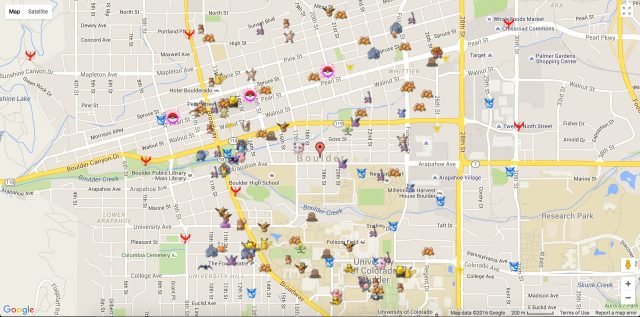
One of Pokémon Go's defining characteristics is that you never quite know the precise location of nearby Pokémon, since the game only gives an imprecise "radar" with general distances. A group of hackers has set out to change that situation, exploiting Pokémon Go's server responses to create an easy-to-use map that reveals those hidden Pokémon in your immediate area.
The hack is the result of efforts by the PokemonGoDev subreddit, which is working to reverse engineer an API using the data sent and received by the Pokémon Go servers. So far, the group has managed to parse the basic server responses sent by the game, which can be acquired through an SSL tunnel and deciphered using relatively basic protocol buffers.
From there, a little bit of Python scripting work can convert the usually hidden data on nearby Pokémon locations into an easy-to-use Google Maps picture of your augmented reality surroundings. There are step-by-step installation instructions for anyone with even a basic understanding of a command line, as well as recent attempts at a self-contained desktop app and Web-based app for those who want a one-step Poké-mapping solution.
Already, people are trying to use this mapping data to crowdsource a complete, worldwide map of all in-game Pokémon. Other apps in the works can notify players when rare Pokémon pop up nearby, spoof GPS coordinates to fool the game into thinking you're in other locations, or even automatically "farm" Pokémon from Pokéstops.
Accessing Pokémon Go data in this way is explicitly against the game's terms of service, which prohibit any "attempt to access or search the Services or Content, or download Content from the Services through the use of any technology or means other than those provided by Niantic or other generally available third-party web browsers." That means your account could be banned if developer Niantic detects you using one of these tools and that you should probably create a new dummy account if you're just curious about seeing the hacks for yourself.Niantic could also take steps to further obfuscate its server data in the future or attempt to block access by unapproved sources from outside the game. Such moves would no doubt lead to a programming arms race between Niantic and hackers eager to keep the game's hidden bits exposed (Niantic Labs wasn't immediately available to respond to a request for comment from Ars Technica).
While mapping previously hidden Pokémon is obviously a good way to speed up advancement in the game, it also robs you of some of the serendipity of discovery that makes Pokémon Go special. Simply walking to a set point on a map ends up being a little less satisfying than stumbling on the hidden critters yourself.This kind of mapping also has the potential to hamper some of the social interactions that have helped the game become an instant hit. After all, why bother asking a nearby player if they found any good Pokémon nearby when you can just call up an app that tells you their location instantly?
That said, developer Ahmed Almutawa, who first posted his Pokémon Go mapper on Saturday evening, doesn't seem worried about these kinds of tools damaging the game experience. "Ever since I've made this, I've had a lot more fun," he said in an interview with The Verge, "mostly because I could see where all the lures are and go to where all the people are hanging out."
That said, Almutawa added that he realizes "it is Niantic's game and they're free to do with it whatever they do. I do hope that they're fine with the map itself [and] it's not causing them any issues."
reader comments
76